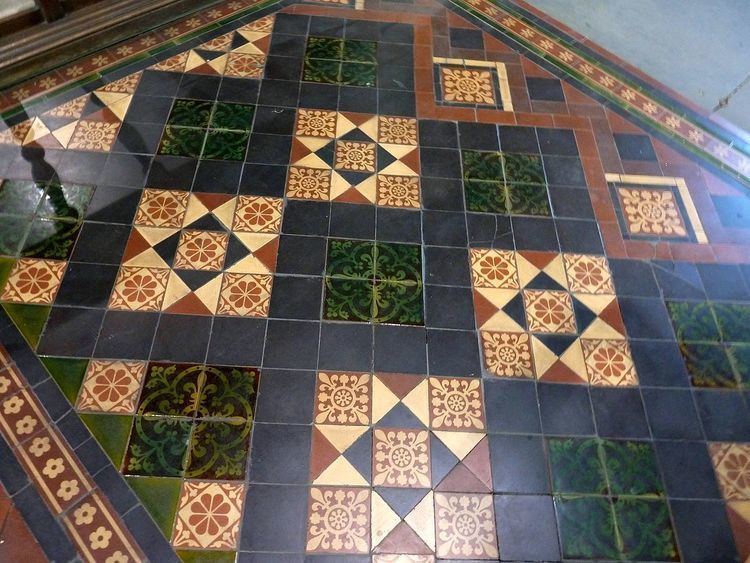Founder George MawArthur Maw Area served Worldwide Founded England | Headquarters England Website mawandco.com Type of business Private Limited Company | |
 | ||
Industry Manufacture of ceramic tiles | ||
Maw & Co have made earthenware encaustic and geometric floor tiles since 1850, when the company was established by George Maw and his brother Arthur. Their first factory was in Worcester and in 1862 the company moved to Broseley, Shropshire in the Ironbridge Gorge. In 1883 they moved to the Benthall Works in Jackfield, Shropshire. The new, purpose-built factory was the largest tile works in the world and the company was the world's largest producer of ceramic tiles, making more than 20 million pieces a year.
Contents
The range of tiles was expanded over the years and included relief tiles, mosaic tiles, transfer printed tiles and hand-painted picture tiles. Designs included Art Nouveau and Art Deco geometric designs. In the 1890s Maw & Co started making high quality art pottery.
History
Maw & Co was established in Worcester in 1850 by brothers George and Arthur Maw. Their father, John Hornby Maw (1800 – 1885), felt that the tile industry would be a good business opportunity for his sons as it combined their artistic talents with their entrepreneurial skills. In 1849 he bought the Encaustic Tile Works in Worcester which had been established by the Worcester Porcelain Company.
They quickly gained a high reputation for their 'mock-mediaeval' encaustic floor tiles. The local clays were unsuitable and clay from Shropshire was brought in at great expense. In 1862 the company moved to Broseley, Shropshire in the Ironbridge Gorge to take advantage of the good-quality local clay. Until full commercial production was reached in 1857, the company barely covered its expenses but, within a few years, encaustic tiles became the height of fashion and the company prospered. By 1861 Maw & Co employed a work force of 83 (45 men, 17 women and 21 boys). The company continued to prosper and by 1880 had grown to be the largest producer of ceramic tiles in the world, making more than 20 million pieces a year. In May 1883 they moved to the Benthall Works at Jackfield, Shropshire. The new purpose-built factory covered an area of 5 acres (2.0 ha) and was the largest tile works in the world.
Maw & Co have supplied ceramic wall and floor tiles to some of the world’s most prestigious buildings. In Maw’s printed catalogues the 'Lists of persons and establishments supplied' ran to five pages and included the British Royal Family, Alexander II of Russia, maharajas, dukes, earls, railway companies, cathedrals, hospitals, public buildings, schools and colleges, and even warships. Maw and Co won many awards at international exhibitions including those in London (1862), Paris (1867), Philadelphia (1876) and Adelaide (1887).
The recession that followed World War I, building restrictions and railway closures were all detrimental to the tile industry. In 1960 Maw & Co merged with Campbell Tiles and In 1968 the Campbell-Maw Company was absorbed into the H & R Johnson group. Maw & Co closed down in January 1970.
Maw & Co Limited was re-established as a private company on 27 June 2001. In March 2008 the company was acquired by new management. Encaustic and geometric floor tiles, and replica Victorian decorative wall tiles, are produced using traditional craft skills. Replica tiles of other leading 19th century makers, such as Minton, Campbell, and Malkin, are also produced.
Products
The earthenware encaustic and geometric floor tiles, that Maw & Co are best known for, have always been produced. In addition, mosaic tiles (from 1862), transfer printed tiles, hand painted picture tiles and relief tiles were also produced and included Art Nouveau and Art Deco geometric designs.
In the 1890s Maw & Co started making high quality art pottery and they employed artists, such as Lewis Foreman Day and Walter Crane, to design both art pottery and tiles.
Two-handled Commemorative Toast Mug
All the workers of Maw & Co contributed to a Benefit Club to enable them to be paid if they became ill. As a gesture of respect and affection for their employers the Club commissioned John Rose and Company (the trading name, at that time, of Coalport China) to make two toast mugs, one for each of the Maw brothers, The mugs were presented to the Maw brothers at the annual meeting of the Benefit Club in 1869. The inscription, on the inside of the lids of the mugs, shows the high regard that the workforce held for their employers and suggests that Maw & Co. were good employers and that their employees were well treated. The inscription reads:
One of the mugs, on loan from the Maw family, is on display at the Jackfield Tile Museum.
